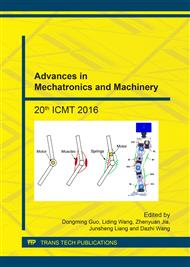[1]
Liu Yajun, Tang Dian, Jr. J Lumkes, Efficiency of Pumping Gasoline in Service Station, IOP Conf. Series: Earth and Environmental Science 15 072007, (2012).
DOI: 10.1088/1755-1315/15/7/072007
Google Scholar
[2]
Liu Yajun, Wang Zhiyong, Wang Wei, Tang Dian, Jr. J Lumkes, Efficiency Model of Pumping Low Viscosity Fluids, IOP Conf. Series: Materials Science and Engineering 52 072002, (2013).
DOI: 10.1088/1757-899x/52/7/072002
Google Scholar
[3]
Wan Qinbo, Research of Fuel Dispenser Pump System based on DSP and Frequency Conversion, South China University of Technology, (2012).
Google Scholar
[4]
Cao Yuquan, Wang Qiong, Li Mengda, Sun Hui, Calculation of Load Efficiency of Pumps and Variable Frequency Speed-Controlling Electric Motors in Oil-piping System, Acta Petrolei Sinica, Vol. 26, No. 2, pp.107-110, (2005).
Google Scholar
[5]
G.O. Garcia, J.C. Mendes Lufs, R.M. Stephan, E.H. Watanabe, An Efficient Controller for an Adjustable Speed Induction Motor Drive, IEEE Transactions on Industrial Electronics, Vol. 41, No. 5, pp.533-539, (1994).
DOI: 10.1109/41.315272
Google Scholar
[6]
Cheng Ming, Cao Ruiwu, Hu Guowen, Cai Guilong, Energy-saving Control based on Stator Voltage-regulation of Asynchronoous motor, Electric Power Automation Equipment, Vol. 28 No. 1, pp.6-11.
Google Scholar
[7]
Wei Danping, Study on The Lubricity of Gasoline Fuels I. A Preliminary Investigation on The Lubricity of European Gasoline Fuels, Acta Petrolei Sinica, Vol. 16, No. 2, pp.7-11, (2000).
Google Scholar
[8]
Wei Danping, Study on The Lubricity of Gasoline Fuels V. Elastohydrodynamic Behaviour of Gasoline, Acta Petrolei Sinica, Vol. 17, No. 2, pp.1-11, (2001).
Google Scholar
[9]
D.P. Wei, H.A. Spikes, S. Korcek, The Lubricity of Gasoline, Tribology Transactions, Vol. 42, No. 4, pp.813-823, (1999).
DOI: 10.1080/10402009908982288
Google Scholar
[10]
J C Anderson, L Flabbi, G Caporiccio. The lubrication of plastics by perfluoropolyether fluids, Synthetic Lubricants, Vol. 5, No. 3, pp.199-214, (1998).
DOI: 10.1002/jsl.3000050304
Google Scholar
[11]
E Cosmacini, V. A Veronesi, Study of The Tribological Behavior of Perfluoropolyethers, Wear, Vol. 108 No. 3, pp.269-283, (1986).
DOI: 10.1016/0043-1648(86)90005-0
Google Scholar


